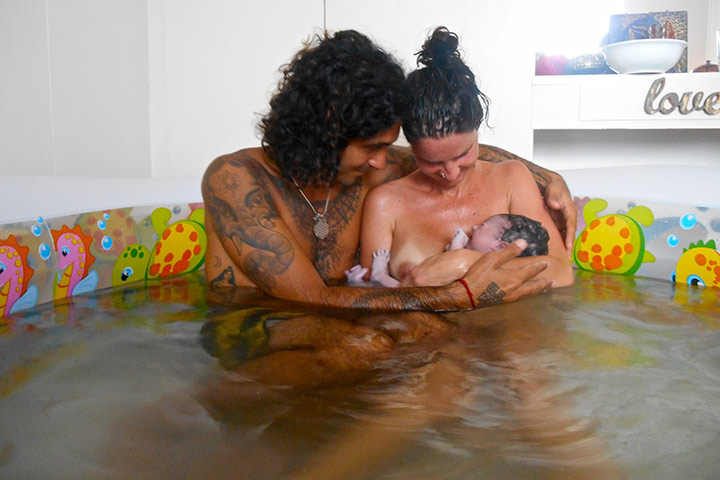
Water birth means having your labor and baby in a pool filled with warm water. It can happen in a hospital or at your home with help from a midwife. Several organizations are encouraging pregnant women to have water births at home, but there are also experts who call it an ‘irresponsible’ act.
Even as the debate on its pros and cons goes on, the number of women opting home births in their own water pools seems to be increasing. Water births are said to provide relief from labor pain. Also, having birth in your own pool means that only you are using it and it is clean and free of any infections.
Meet Cécille, one of those women who vote for home water birthing. She had two births this way. Her son Hayan was born on 14 February 2016 in three-and-a-half hours. The picture here was taken moments after Hayan arrived into the world. He is her second child. Cécile describes the experience right from her first contraction to holding him against her heart as a “powerful feeling of unconditional love and great joy”.
Earlier, Cécille gave birth to her daughter Nayara on 6 December 2014 at home. This too was water-birthing as Hayan’s elder sister arrived in just under eight hours in the same swimming pool! “My first transformational birth experience, an incredible spiritual experience,” is how Cécille looks back at Nayara’s arrival.
It is said that immersion in water during the first stage of birthing alleviates the labor pain. The belief is backed up by theories that immersion reduces pain, it allows the mother to assume a comfortable position and that the warmth of water may produce a sedative effect (1). Immersion acts as a natural anesthesia, whereby you don’t have any risk of trauma or complications of anesthesia.
Interestingly, water immersion is said to be especially beneficial in reducing the rate of a C-section delivery and also reduced stress urinary incontinence symptoms 42 days after delivery. A 2014 review suggests that there is no obvious increase in the rate of infections for either the mother or the baby.
However, the American College of Obstetricians and Gynecologists and the American Academy of Pediatrics warn that immersion in water could be beneficial in the first stage of labor but there is no proof about its safety and efficacy in the second stage. (2)
Moreover, water birthing is not recommended under certain situations. It is not suitable if:
- you have herpes as it can transfer into the water. So, this is something you need to discuss with your healthcare provider.
- you know your baby is breech. You need to discuss with the healthcare provider to understand about the risks involved.
- there is excessive bleeding or maternal infection.
- you have multiple babies (twins or more).
- you have preterm labor by about two weeks before the due.
- if there is any meconium (mild to moderate), then your midwife will remove it from the tub at once. But if there is severe meconium, then you might be advised to lift your pelvis out of the water to birth the infant. Meconium washes off your baby’s face and might even come out through the mouth and nose of your baby while it is still under water.
- you have preeclampsia or toxaemia.
What you also need to bear in mind about water birthing is that the temperature must be optimum for birthing. If the water is too hot, it can lead to dehydration and overheating of both your baby and you. If the temperature is 97 degrees Fahrenheit, you are pretty much hydrated. But most birth pools are designed to address this problem.
Should you take the appropriate precautions, you are going to be on your way to a successful water birth.














